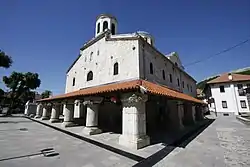Serbian Orthodox Church in Kosovo
The Serbian Orthodox Church in Kosovo[lower-alpha 1] is the second largest religious denomination after Islam. It has 100,000-120,000 followers in Kosovo, predominantly made up of the Kosovo Serbs, who mostly live in the North Kosovo region and in some enclaves in the south (such as Štrpce).[1]
During 1999–2004, 140 Serbian Orthodox churches were destroyed. 30 of those were destroyed in the 2004 unrest in Kosovo, and many were destroyed in the 2008 unrest in Kosovo.
Kosovo War
Serbian Orthodox Church supported Miliošević's attempt to end the victimisation of Kosovo Serbs, but it also opposed the use of violence, which resulted in the Serbian Patriarch Pavle publicly criticizing Milosevic in 1990.[2] According to Anna Di Lellio SOC in Kosovo announced a series of strategies to cleanse the Albanian population from Kosovo in the Serbian Academy of Sciences and Arts, prior to Kosovo War.[3]
Annotations
- Kosovo is the subject of a territorial dispute between the Republic of Kosovo and the Republic of Serbia. The Republic of Kosovo unilaterally declared independence on 17 February 2008. Serbia continues to claim it as part of its own sovereign territory. The two governments began to normalise relations in 2013, as part of the 2013 Brussels Agreement. Kosovo is currently recognized as an independent state by 98 out of the 193 United Nations member states. In total, 113 UN member states recognized Kosovo at some point, of which 15 later withdrew their recognition.
References
- United States Department of State
- Group, International Crisis (2001). RELIGION IN KOSOVO (PDF). Pristina/Brussels: ICG Balkans Report. p. iii. Retrieved 5 January 2020.
- Lellio, Anna Di (2006). The Case for Kosova: Passage to Independence. Anthem Press. p. 141. ISBN 978-0-85728-712-0. Retrieved 5 January 2020.

